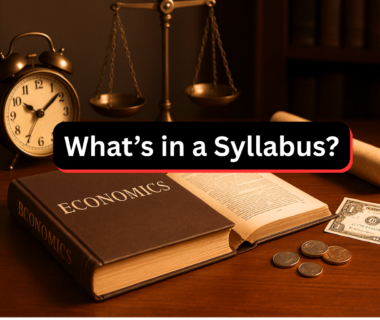Hello sepupus, welcome back!
In today’s post, I want to talk about something that is surely going to be relevant to a lot of you: the IGCSE Economics syllabus.
A syllabus, as some of you may know or may not know, is defined as follows:
Syllabus: a summary outline of topics to be covered in a course of instruction.
First off, there are a few different syllabi for IGCSE Economics and a range of different exam boards.
While I will be focusing on the Cambridge IGCSE 0455 syllabus here, if you happen to work with a different exam board, understand this:
Understanding the syllabus is going to be important for you to understand the scope of topics that you are going to deal with. Really specifically, understanding what a syllabus is will help you understand:
- What are the goals of my course?
- What topics do I need to learn about?
- How will I be assessed?
- What are the formats of the exams I’m going to take?
- How long are each of these exams?
Therefore, understand your syllabus regardless of what syllabus you happen to be dealing with and whatever subject code. The textbooks can come a little later.
Just to illustrate how the differences can play out, consider the difference between the aims for the 2026 vs the 2029 versions of the IGCSE economic syllabus by Cambridge.
For 2026 syllabus students (students taking the exam next year!)
The aims are to enable students to:
- know and understand economic terminology, concepts and theories
- use basic economic numeracy and interpret economic data
- use the tools of economic analysis
- express economic ideas logically and clearly in a written form
- apply economic understanding to current economic issues.
Compare and contrast this with the 2027-2029 syllabus.
The aims are to enable students to:
- explore the purpose and role of economists in investigating economic issues and problems
- build a confident working knowledge of key economic terms, concepts and theories
- use the tools of economic analysis to interpret different types of data and information
- analyse possible outcomes for economic problems and express ideas logically
- consider how issues such as population change, globalisation and environmental sustainability can impact
economic policy-making- discover the impact and importance of economics, inspiring an interest that could lead to further study or
employment.
Having said all of that, there are some similarities and differences across the Cambridge syllabi, which we will discuss.
Most importantly, all Cambridge syllabi in economics maintain that you learn about:

And now, here’s a structured comparison that tells you about all the different syllabi.
✅ Commonalities
- Subject Content Topics
All three syllabi cover the same six core areas:- The basic economic problem
- The allocation of resources
- Microeconomic decision-makers
- Government and the macroeconomy
- Economic development
- International trade and globalisation
- Assessment Objectives (AOs)
- AO1: Knowledge and understanding
- AO2: Analysis
- AO3: Evaluation
These three AOs are used consistently across all syllabi to guide assessment design and weightage.
- Skills Emphasized
Each syllabus highlights:- Use of economic terminology
- Application of economic analysis to data
- Diagrammatic interpretation
- Logical expression and reasoning
- Real-world application of economic concepts
- Two-Paper Structure
All versions use:- Paper 1: Multiple-choice
- Paper 2: Structured questions
🔄 Differences
| Feature | 2023–2025 | 2026 | 2027–2029 |
|---|---|---|---|
| Paper 1 Duration | 45 minutes, 30 marks | 45 minutes, 30 marks | 1 hour, 40 marks ✅ Longer and more in-depth |
| Paper 2 Duration | 2h 15 min, 90 marks | 2h 15 min, 90 marks | 2 hours, 80 marks ❗Shorter but slightly fewer marks |
| AO3 (Evaluation) Weightage | 20% of total | 20% of total | 10% only ➜ Less emphasis on evaluation |
| Structure of AO Weighting (Paper 2) | AO3 = 30% | AO3 = 30% | AO3 = 15% |
| Command Words Section | Introduced earlier | Present | Present with updated emphasis |
| Subject Content Detail | Dense, moderately structured | Same as 2023–2025 | Refined and reorganized for clarity; some topic naming updated (e.g., ‘firms’ costs, revenue, and objectives’) |
| Support Philosophy Emphasis | Strong | Same | More emphasis on environmental sustainability and climate action |
✍️ Interpretation
- The 2027–2029 syllabus reflects a shift toward greater analytical and conceptual breadth, particularly with a slightly longer Paper 1 and reduced AO3 weighting, indicating a less exam-based emphasis on judgment and evaluation.
- The 2026 and 2023–2025 versions are nearly identical, showing continuity before the more modern refresh for 2027 onward.
- Cambridge is increasingly emphasizing sustainability, data-led insights, and global challenges, especially in the newest version.
All right, now let’s draw back from where we were.
The IGCSE Economics syllabus (no matter what year, although how it manifests) follows a clean, logical arc:
- Scarcity and constraints (basic problem)
- Resource allocation mechanisms
- Who makes decisions (micro agents)
- Government and macro policy
- Development issues
- Global trade context
It’s structured like a funnel from individual choice → institutional response → global integration.
That’s the direction that the syllabus takes you in.
Does this help?
Sure, it gives you an idea of how economics works – this is what you’re going to learn, this is what we are going to talk about. But is it enough? We’ll talk more about that very soon.
But is it limited, sepupus?
Well, if you have some real world experience or you’d like some complexity, you might feel that way – and we will talk more about that.
For now, get yourselves ready to learn, and let your brains begin to ask the questions that they have begun to form.
See you in the next one!
